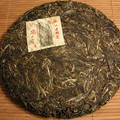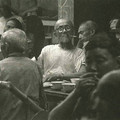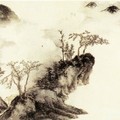Theme - Cake
Teas - Cake
2009 Cha Shu Wang "Jing Mai Chun Liao Cha"
 0 reviews
0 reviewsThis Pu-erh is called "Jing Mai Chun Liao Cha" (景迈纯料茶) - Jing Mai Mountain Pure Material Tea. The...
2016 Chawangpu Bada Laoyu Raw Puerh Cake 400g
 0 reviews
0 reviewsLao Yu (老妪) : old woman Material for this cake came from a small Bulang village in...
2016 Myanmar Jingdong Xiao Bing Cha 200g
 0 reviews
0 reviewsThe raw materials of this cake came from Jingdong, Myanmar, just west of the Xishuangbanna. The...
2016 Chawangpu Yibang Manguishan Xiao Bing
 0 reviews
0 reviewsLast winter was unusually cold. Many people thought they would have a good harvest the next...
2015 White 2 Tea Pin
 0 reviews
0 reviews2015 Pin Raw Puer Tea 200g from White2tea. The Pin is a blend of three years of high quality...
2006 Changtai Long Ma Rui Ming "Dragon Horse"
 1 review
1 reviewThis cake is composed of Lancang and Menghai area selected materials.After 5 years aging in dry...
Quotes - Cake
„The most classical Puerh Tea is the Bingcha, recorded in Yong-Zheng 13th year in Qing Dynasty (1735). Each tea cake weighs 7 Liang (357 grams). Seven cakes make 1 Tong (wrapped in leaves), weighing 49 Liang. It was sold in nice places and also was exported abroad. It was re-named as "Yunnan Qizi bingcha - Yunnan seven cake tea" during the Cutural revolution.“
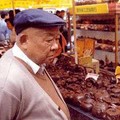
Quotes Tags: Pu-erh, Cake, Tea production, China
„Yunnan Tea Company standardized the trade number for Pu Erh Tea in 1976 for the purpose of export. Each bingcha has 4 digits: the first 2 digits indicate the manufacturing year, the third digit indicates the leaf grade, the last digit indicates the tea factory (e.g. Kun-Ming 1, Meng-Hai 2, Xia-Guan 3, Pu Erh 4). The loose-leaf tea has 5 digits with the third and fourth indicating the class level of raw materials. Examples of early trade numbers for Puerh Tea are 7452, 7562, 7572, 75671, 76563.“
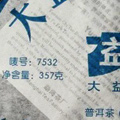
Quotes Tags: Pu-erh, Tea production, Cake, China
„Nèi fēi (内飞 or 內飛): A small ticket originally stuck on the tea cake but now usually embedded into the cake during pressing. It is usually used as proof, or a possible sign, to the authenticity of the tea. Some higher end pu'er cakes have more than one nèi fēi embedded in the cake. The ticket usually indicates the tea factory and brand.“
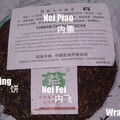
Photos - Cake
Video - Cake
Tea by region
Remember what tea did you drink year ago?
Create your own collection of favorite teas and keep the track what you have drunk.
We will help you with tea selection.
Do you like quality loose tea?
We will help you to find the right one for you. Be inspired by tea ratings of other tea lovers. Rating stars could help you.


Latest posts
07.06.2025 @ 07:48:53 - lalo233:
The unforgiving landscapes of Arrakis in Dune: Awakening demand a mastery of combat....
07.06.2025 @ 07:48:50 - lalo233:
The unforgiving landscapes of Arrakis in Dune: Awakening demand a mastery of combat....
01.01.2016 @ 18:14:35 - Eternal Spring:
WeRateTea.com wish you all the best for 2016!...
07.12.2015 @ 09:07:02 - sypalino:
I decided to taste this tea 2 weeks after delivery. The cake is lightly pressed, so...
09.11.2015 @ 21:58:19 - Eternal Spring:
Comparison of 2013 Bada Pu-erh.sk with <a...
09.11.2015 @ 09:34:07 - Eternal Spring:
Lao Yu 2013 is now about 2,5 years old tea and out of this 1,5 year stored in Europe....
09.11.2015 @ 09:33:11 - Eternal Spring:
Comparison of all three Lao Yu is now done :)
15.10.2015 @ 11:06:37 - Eternal Spring:
2015 Chawangpu Collection – I can only tell, that all teas are very good :)
09.10.2015 @ 10:31:19 - Eternal Spring:
It was quite long and difficult tasting to make a decision… There is still quite...
24.01.2015 @ 16:55:57 - Eternal Spring:
WeRateTea.com wish you all the best for 2015!...
Review your cup of tea.
Review the tea you are drinking and help other tea lovers to find the right cup of tea.



Theme
Quotes
„Nèi fēi (内飞 or 內飛): A small ticket originally stuck on the tea cake but now usually embedded into the cake during pressing. It is usually used as proof, or a possible sign, to the authenticity of the tea. Some higher end pu'er cakes have more than one nèi fēi embedded in the cake. The ticket usually indicates the tea factory and brand.“



 Shops
Shops





 Share on Facebook
Share on Facebook
